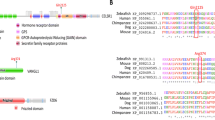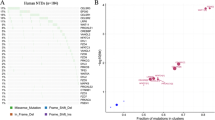Abstract
Select single-nucleotide variants in planar cell polarity (PCP) genes are associated with increased risk for neural tube defects (NTDs). However, whether copy number variants (CNVs) in PCP genes contribute to NTDs is unknown. Considering that CNVs are implicated in several human developmental disorders, we hypothesized that CNVs in PCP genes may be causative factors to human NTDs. DNA from umbilical cord tissues of NTD-affected fetuses and parental venous blood samples were collected. We performed a quantitative analysis of copy numbers of all exon regions in the VANGL1, VANGL2, CELSR1, SCRIB, DVL2, DVL3, and PTK7 genes using a CNVplex assay. Quantitative real-time PCR (qPCR) was carried out to confirm the results of CNV analysis. As a result, 16 CNVs were identified among the NTDs. Of these CNVs, 5 loci were identified in 11 NTD probands with CNVs involving DVL2 (exons 1–15), VANGL1 (exons 1–7, exon 8), and VANGL2 (exons 5–8, exons 7 and 8). One CNV (DVL2 exons 1–15) was a duplication and the remaining 15 CNVs were deletions. Eleven CNVs were confirmed by qPCR. One de novo CNV in VANGL1 and one DVL2 were detected from two cases. Compared with unaffected control populations in 1000 Genome, ExAC, MARRVEL, DGV, and dbVar databases, the frequencies of de novo deletion in VANGL1 (1.14%) and de novo duplication in DVL2 (0.57%) were significantly higher in our NTD subjects (p < 0.05). This study demonstrates that de novo CNVs in PCP genes, notably deletions in VANGL1 and gains in DVL2, could contribute to the risk of NTDs.


Similar content being viewed by others
Data availability
The datasets generated during and/or analyzed during the current study are available from the corresponding author on reasonable request.
References
Zaganjor I, Sekkarie A, Tsang BL, Williams J, Razzaghi H, Mulinare J, Sniezek JE, Cannon MJ, Rosenthal J (2016) Describing the prevalence of neural tube defects worldwide: a systematic literature review. PLoS One 11:e0151586. https://doi.org/10.1371/journal.pone.0151586
Liu J, Zhang L, Li Z, Jin L, Zhang Y, Ye R et al (2016) Prevalence and trend of neural tube defects in five counties in Shanxi province of Northern China, 2000 to 2014. Birth Defects Res A Clin Mol Teratol 106:267–274. https://doi.org/10.1002/bdra.23486
Ma C, Peng Z, Yixin S (2019) Progress in research into spinal cord injury repair: Tissue engineering scaffolds and cell transdifferentiation. J Neurorestoratol 07:196–206. https://doi.org/10.26599/JNR.2019.9040024
Wallingford JB, Niswander LA, Shaw GM, Finnell RH (2013) The continuing challenge of understanding, preventing, and treating neural tube defects. Science 339:1222002. https://doi.org/10.1126/science.1222002
Wilde JJ, Petersen JR, Niswander L (2014) Genetic, epigenetic, and environmental contributions to neural tube closure. Annu Rev Genet 48:583–611. https://doi.org/10.1146/annurev-genet-120213-092208
Goodrich LV, Strutt D (2011) Principles of planar polarity in animal development. Development 138:1877–1892. https://doi.org/10.1242/dev.054080
Gray RS, Roszko I, Solnica-Krezel L (2011) Planar cell polarity: coordinating morphogenetic cell behaviors with embryonic polarity. Dev Cell 21:120–133. https://doi.org/10.1016/j.devcel.2011.06.011
Greene ND, Stanier P, Copp AJ (2009) Genetics of human neural tube defects. Hum Mol Genet 18:R113–R129. https://doi.org/10.1093/hmg/ddp347
Juriloff DM, Harris MJ (2012) A consideration of the evidence that genetic defects in planar cell polarity contribute to the etiology of human neural tube defects. Birth Defects Res A Clin Mol Teratol 94:824–840. https://doi.org/10.1002/bdra.23079
Lei YP, Zhang T, Li H, Wu BL, Jin L, Wang HY (2010) VANGL2 mutations in human cranial neural-tube defects. N Engl J Med 362:2232–2235. https://doi.org/10.1056/NEJMc0910820
Lei YP, Fathe K, McCartney D, Zhu H, Yang W, Ross ME et al (2015) Rare LRP6 variants identified in spina bifida patients. Hum Mutat 36:342–351. https://doi.org/10.1002/humu.22750
Wang L, Xiao Y, Tian T, Jin L, Lei Y, Finnell RH, Ren A (2018) Digenic variants of planar cell polarity genes in human neural tube defect patients. Mol Genet Metab 124:94–100. https://doi.org/10.1016/j.ymgme.2018.03.005
Cook EH Jr, Scherer SW (2008) Copy-number variations associated with neuropsychiatric conditions. Nature 455:919–923. https://doi.org/10.1038/nature07458
Mefford HC, Sharp AJ, Baker C, Itsara A, Jiang Z, Buysse K, Huang S, Maloney VK, Crolla JA, Baralle D, Collins A, Mercer C, Norga K, de Ravel T, Devriendt K, Bongers EMHF, de Leeuw N, Reardon W, Gimelli S, Bena F, Hennekam RC, Male A, Gaunt L, Clayton-Smith J, Simonic I, Park SM, Mehta SG, Nik-Zainal S, Woods CG, Firth HV, Parkin G, Fichera M, Reitano S, Giudice ML, Li KE, Casuga I, Broomer A, Conrad B, Schwerzmann M, Räber L, Gallati S, Striano P, Coppola A, Tolmie JL, Tobias ES, Lilley C, Armengol L, Spysschaert Y, Verloo P, de Coene A, Goossens L, Mortier G, Speleman F, van Binsbergen E, Nelen MR, Hochstenbach R, Poot M, Gallagher L, Gill M, McClellan J, King MC, Regan R, Skinner C, Stevenson RE, Antonarakis SE, Chen C, Estivill X, Menten B, Gimelli G, Gribble S, Schwartz S, Sutcliffe JS, Walsh T, Knight SJL, Sebat J, Romano C, Schwartz CE, Veltman JA, de Vries BBA, Vermeesch JR, Barber JCK, Willatt L, Tassabehji M, Eichler EE (2008) Recurrent rearrangements of chromosome 1q21.1 and variable pediatric phenotypes. N Engl J Med 359:1685–1699. https://doi.org/10.1056/NEJMoa0805384
Gao Y, Wang J, Shangguan S, Bao Y, Lu X, Zou J, Dai Y, Liu J, Zhang T (2018) Quantitative measurement of PARD3 copy number variations in human neural tube defects. Cell Mol Neurobiol 38:605–614. https://doi.org/10.1007/s10571-017-0506-0
Wang J, Wang X, Guan T, Xiang Q, Wang M, Zhang Z, Guan Z, Wang G, Zhu Z, Xie Q, Li G, Guo J, Wang F, Zhang Z, Niu B, Zhang T (2014) (2014). Analyses of copy number variation reveal putative susceptibility loci in MTX-induced mouse neural tube defects. Dev Neurobiol 74:877–893. https://doi.org/10.1002/dneu.22170
Bassuk AG, Muthuswamy LB, Boland R, Smith TL, Hulstrand AM, Northrup H, Hakeman M, Dierdorff JM, Yung CK, Long A, Brouillette RB, Au KS, Gurnett C, Houston DW, Cornell RA, Manak JR (2013) Copy number variation analysis implicates the cell polarity gene glypican 5 as a human spina bifida candidate gene. Hum Mol Genet 22:1097–1111. https://doi.org/10.1093/hmg/dds515
Chen X, Shen Y, Gao Y, Zhao H, Sheng X, Zou J, Lip V, Xie H, Guo J, Shao H, Bao Y, Shen J, Niu B, Gusella JF, Wu BL, Zhang T (2013) Detection of copy number variants reveals association of cilia genes with neural tube defects. PLoS One 8:e54492. https://doi.org/10.1371/journal.pone.0054492
Zhang X, Xu Y, Liu D, Geng J, Chen S, Jiang Z et al (2015) A modified multiplex ligation-dependent probe amplification method for the detection of 22q11.2 copy number variations in patients with congenital heart disease. BMC Genomics 16:364. https://doi.org/10.1186/s12864-015-1590-5
Livak KJ, Schmittgen TD (2001) Analysis of relative gene expression data using real-time quantitative PCR and the 2(-delta delta C(T)) method. Methods 25:402–408. https://doi.org/10.1006/meth.2001.1262
Thapar A, Cooper M (2013) Copy number variation: what is it and what has it told us about child psychiatric disorders? J Am Acad Child Adolesc Psychiatry 52:772–774. https://doi.org/10.1016/j.jaac.2013.05.013
Schrider DR, Hahn MW (2010) Gene copy-number polymorphism in nature. Proc Biol 277:3213–3221. https://doi.org/10.1098/rspb.2010.1180
Eichler EE, Zimmerman AW (2008) A hot spot of genetic instability in autism. N Engl J Med 358:737–739. https://doi.org/10.1056/NEJMe0708756
Weiss LA, Shen Y, Korn JM (2008) Association between microdeletion and microduplication at 16p11.2 and autism. N Engl J Med 358:667–675. https://doi.org/10.1056/NEJMoa075974
Girirajan S, Dennis MY, Baker C, Malig M, Coe BP, Campbell CD, Mark K, Vu TH, Alkan C, Cheng Z, Biesecker LG, Bernier R, Eichler EE (2013) Refinement and discovery of new hotspots of copy-number variation associated with autism spectrum disorder. Am J Hum Genet 92:221–237. https://doi.org/10.1016/j.ajhg.2012.12.016
Kibar Z, Torban E, McDearmid JR, Reynolds A, Berghout J, Mathieu M et al (2007) Mutations in VANGL1 associated with neural-tube defects. N Engl J Med 356:1432–1437. https://doi.org/10.1056/NEJMoa060651
Torban E, Patenaude AM, Leclerc S, Rakowiecki S, Gauthier S, Andelfinger G, Epstein DJ, Gros P (2008) Genetic interaction between members of the Vangl family causes neural tube defects in mice. Proc Natl Acad Sci U S A 105:3449–3454. https://doi.org/10.1073/pnas.0712126105
Cai C, Shi O, Wang B, Chang B, Yang R, Wang Y, Wang F, Shen C (2014) Association between VANGL1 gene polymorphisms and neural tube defects. Neuropediatrics 45:234–239. https://doi.org/10.1055/s-0033-1364103
Hamblet NS, Lijam N, Ruiz-Lozano P, Wang J, Yang Y, Luo Z, Mei L, Chien KR, Sussman DJ, Wynshaw-Boris A (2002) Dishevelled 2 is essential for cardiac outflow tract development, somite segmentation and neural tube closure. Development 129:5827–5838. https://doi.org/10.1242/dev.00164
Torban E, Wang HJ, Groulx N, Gros P (2002) Independent mutations in mouse Vangl2 that cause neural tube defects in looptail mice impair interaction with members of the Dishevelled family. J Biol Chem 279:52703–52713
Iyer J, Girirajan S (2015) Gene discovery and functional assessment of rare copy-number variants in neurodevelopmental disorders. Brief Funct Genomics 14:315–328. https://doi.org/10.1074/jbc.M408675200
Girirajan S, Campbell CD, Eichler EE (2011) Human copy number variation and complex genetic disease. Annu Rev Genet 45:203–226. https://doi.org/10.1146/annurev-genet-102209-163544
Sebat J, Lakshmi B, Malhotra D, Troge J, Lese-Martin C, Walsh T, Yamrom B, Yoon S, Krasnitz A, Kendall J, Leotta A, Pai D, Zhang R, Lee YH, Hicks J, Spence SJ, Lee AT, Puura K, Lehtimaki T, Ledbetter D, Gregersen PK, Bregman J, Sutcliffe JS, Jobanputra V, Chung W, Warburton D, King MC, Skuse D, Geschwind DH, Gilliam TC, Ye K, Wigler M (2007) Strong association of de novo copy number mutations with autism. Science 316:445–449. https://doi.org/10.1126/science.1138659
Xu B, Roos JL, Levy S, van Rensburg EJ, Gogos JA, Karayiorgou M (2008) Strong association of de novo copy number mutations with sporadic schizophrenia. Nat Genet 40:880–885. https://doi.org/10.1038/ng.162
Code availability
Not applicable
Funding
This work was supported by grants from the National Natural Science Foundation of China (Grant Nos. 81773441 and 81472987), and the Ministry of Science and Technology of the People’s Republic of China (Grant No. 2016YFC1000501).
Author information
Authors and Affiliations
Contributions
Tian Tian was responsible for data analysis and manuscript revisions. Linlin Wang designed the study and wrote the first draft of paper. Aiguo Ren was responsible for subject recruitment, participated in study design, and critically commented on the manuscript. Yunping Lei helped study design and revised the manuscript. Lei Jin participated in subject enrollment. Yongyan Chen and Yinnan Guo participated in laboratory experiment. Richard H. Finnell helped to revise the manuscript.
Corresponding authors
Ethics declarations
Conflict of interest
The authors declare that they have no conflict of interest.
Ethics approval
The study protocol was approved by the institutional review board of Peking University.
Consent to participate
Written informed consent was obtained from the mothers and fathers prior to questionnaire interview and sample collection.
Consent for publication
Not applicable
Additional information
Publisher’s note
Springer Nature remains neutral with regard to jurisdictional claims in published maps and institutional affiliations.
Electronic supplementary material
ESM 1
(DOCX 843 kb)
Rights and permissions
About this article
Cite this article
Tian, T., Lei, Y., Chen, Y. et al. Rare copy number variations of planar cell polarity genes are associated with human neural tube defects. Neurogenetics 21, 217–225 (2020). https://doi.org/10.1007/s10048-020-00613-6
Received:
Accepted:
Published:
Issue Date:
DOI: https://doi.org/10.1007/s10048-020-00613-6




